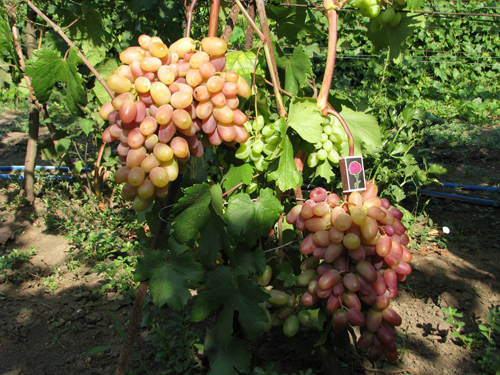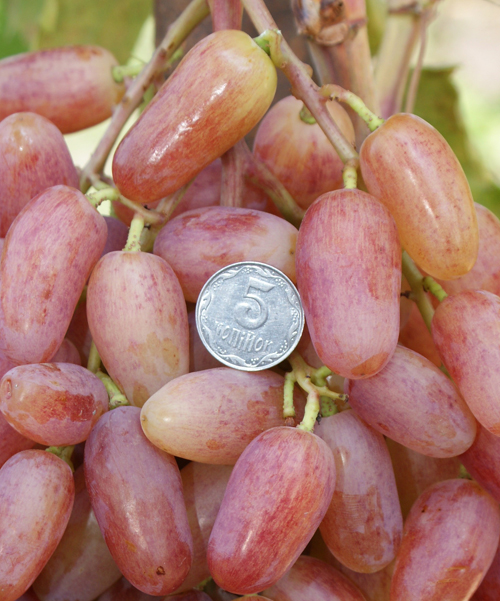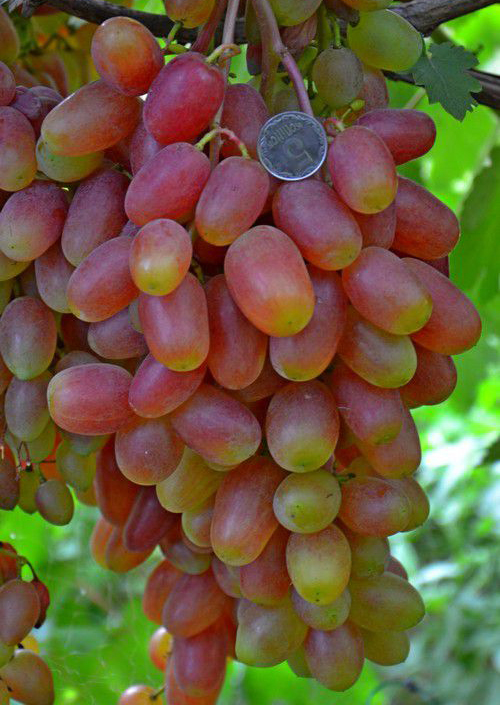Grape variety Victor
A hybrid form of table grapes called Victor is one of the best bred by the famous amateur breeder V.N. Krainov from the city of Novocherkassk, Rostov region of the Russian Federation. For many decades, starting from the age of 15, Viktor Nikolaevich was engaged in the cultivation of grapes on his site, but he began to create his own varieties only in 1995. Thanks to the acquaintance with scientists of the well-known All-Russian Research Institute of Life Sciences named after V.I. ME AND. Potapenko, in a new field for himself, the national breeder very quickly began to demonstrate impressive results, one after another giving birth to promising hybrid forms of a very attractive appearance, which instantly gained popularity among winegrowers. In just a decade and a half of active breeding work, he created almost fifty varieties of grapes, many of which are widespread among amateurs, and some are even allowed to be grown in industrial plantings.

Victor was introduced to the general public at the very beginning of the 2000s and quickly gained popular popularity for its large size, attractive colors and excellent taste of early ripening bunches and berries. The hybrid became one of the representatives of the famous "Krainov's three" - magnificent varieties with slightly different morphological characteristics of plants, but very similar bunches to each other. All of them - Transformation, Anniversary of Novocherkassk and Victor, descended from the same parental couple, in which the famous large-fruited and disease-resistant Mascot, and the father's - seedless grapes of Moldovan selection Radiant kishmish... The choice of the parents did not disappoint the author of these masterpieces, thanks to which the name of V.N. Krainova is inscribed in golden letters in the history of domestic grape breeding. His outstanding successes prompted many winegrowers to follow his example, and today they continue to explore and create, creating more and more wonderful varieties of this beautiful plant. The official recognition of his merits was that two of the three varieties of the "troika" - Preobrazhenie and Jubilee Novocherkassk, in 2014 and 2016, respectively, were included in the State Register of Breeding Achievements of the Russian Federation. There is no doubt that sooner or later Victor should also be there - a grape that is in no way inferior to the first two either in yield, or in the splendor of the quality of the fruits, and in the simplicity of even surpassing them.
Agrobiological characteristics
The vigor of the bushes is high. The crown of the shoot is green with a barely noticeable bronze tint, without pubescence. The leaves are very large, rounded, five-lobed, moderately dissected. The upper lateral notches are deep, open, slit or lyre-shaped, with a narrow aperture and a rounded bottom. The lower notches are barely marked or absent. The petiole notch is open, vaulted, with a pointed bottom. The denticles along the edge of the leaf blade are large, saw-shaped, with a wide base and rounded apices. The flowers of the variety are bisexual, well pollinated with their own pollen and are not prone to peeling berries.

Bunches of grapes are large, their average weight is 600-1000 grams, but some specimens grow up to 2 kg, cylindrical-conical or shapeless, have an average density. The comb is long, the stems of the berries are of medium length, firm, light green in color. Viktor's berries are oval-oblong, often with a pointed end, very large, up to 40 and even up to 45 mm long, up to 28 mm in diameter and weighing 15-18 grams. The size of the berries depends on the number of them in the bunch; on small clusters, individual grapes reach a length of 60 mm. The pulp is dense, fleshy-rich, harmonious, noble taste without bright specific tones. The skin is moderately dense, crispy, and eaten. The color of the berries varies from yellowish-pink to crimson; on the surface there is a small protective waxy layer of light color.There are few seeds - 1-2 pieces, when used they are almost not felt. A positive feature of the variety is the uniform ripening of the berries, despite the impressive size of the bunches. The crop can continue to hang on the bushes for a long time after the onset of removable maturity, without cracking or rotting. Thanks to the strong skin, Victor's berries are very rarely damaged by wasps.
The grapes are very good for fresh consumption, but they are also quite suitable for making compotes, jams, juices. It has an excellent presentation, suitable for long-distance transportation and storage in refrigerators. Bunches that have reached a bright color are especially attractive to buyers, to achieve which is a task for an experienced winegrower.
The ripening period of the crop is early. The growing season from bud break to removable ripeness is 100-110 days. In the south, harvesting can start as early as early August. At the same time, thanks to the small amount of required active temperatures (2200-2300 ° C), Victor succeeds very well in quite northern regions, and in traditional ones, even clusters of stepchildren manage to ripen. The yield is stable but moderate. An average of 8-10 kilograms of grapes are harvested from the bush.

The frost resistance of the variety is at the level of other varieties of the "troika" (-22 -23 ° С). Ripening of shoots is good. Fruitfulness is high - up to three brushes are laid on each shoot, the extra of which must be removed. The sugar content of the juice is average - 17 g / 100 cubic meters. cm, acidity - about 8 g / liter. The ratio of acid and sugar in the taste is harmonious.
Agrotechnical features
Among the varieties of the magnificent "Krainov's three", Victor is distinguished by the best resistance to such harmful fungal diseases as mildew, oidium, gray rot. This, of course, does not mean that there is no need to fight them, but to control pathogens in a normal, not too wet year, two preventive fungicide treatments will be enough. There is no information about the resistance of the variety to phylloxera, and therefore it is better to reproduce it in regions infected with this pest by grafted seedlings on a resistant stock. On phylloxera-free soils, grapes root well and grow on their own roots.
The form of bushes management depends on the climatic conditions of the growing area. In frost-dangerous places, where temperatures are not uncommon for a given hybrid, the vine is formed so that it can be conveniently and without damage to cover it for the winter. These can be inclined cordons or multi-arm fan formations, the main condition is a low location above the ground, which facilitates the removal of vines from the trellis in autumn. In the southern latitudes, with their mild winters, it is possible to grow plants on a high trunk, with powerful cordons and branches. Such bushes develop well and show significantly higher yields.
The load on a grape bush in accordance with the selected bush management scheme and the volume of accumulated perennial wood can vary - from 30 to 45 eyes per bush. The length of the pruning is not critical, and usually with fan-shaped formations, the fruit arrows of the variety are cut long (by 8-12 eyes), and on cordon ones, with numerous fruit links - shortly (4-6 buds).
In addition to the danger of damage by winter frosts, Victor, due to the early onset of flowering, risks falling under return spring frosts. Therefore, in the northern cultivation regions, bushes must be placed on the southern side of walls, hedges, fences, which will at least slightly protect them from cold winds. The most effective measure will be to protect the vineyard, which has started to grow, with the help of smoke from fires on those nights when the temperature is predicted to drop below zero.
To prevent overloading the bushes, carry out green operations with them on time and with high quality, removing weak and sterile shoots, and most importantly, extra inflorescences, leaving only one for each fruitful shoot.
As for the intensity of the color of the grape bunches, which many want to achieve in order to improve the presentation of the harvest, then, according to those who are already growing varieties from the Krainov Troika, they acquire the best color when growing in the shade. And Victor is no exception.In the sun, the bunches are baked, ripening quickly, but without having time to get an elegant skin color. There are no problems in this regard among winegrowers who grow the variety in northern regions, not too spoiled by the sun and summer heat. It remains for the winegrowers of the southern zone to recommend not too actively lightening the bunches, giving them the opportunity to acquire an elegant pink color in the shade of their own foliage.








